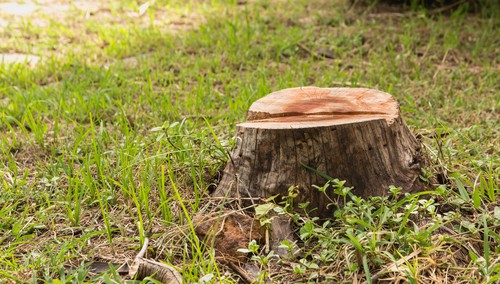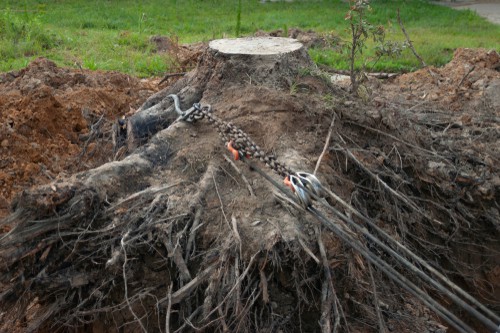Last updated on March 27th, 2022
Our site is reader supported, this means we may earn a small commission from Amazon and other affiliates when you buy through links on our site.
When trees fall, or when you have them removed, the stumps often remain. It’s important to remove them to prevent root rot but mostly because of suckering. Suckering is where new shoots grow out of the trunk you left behind, trying desperately to become new trees. Now, if the tree stump is completely dead, you won’t run this risk, but in its place, you will have to contend with things like honey fungus. In the end, it is better to remove them. With the right techniques and/or equipment, you can safely remove any tree stumps still in your path.

When to remove tree stumps
You can remove tree stumps at any time. The easiest time is, of course, right when the professionals are cutting the tree down in the first place, in this cost they usually use trunk busters to grind the tree stump away right down below the soil. However, if you didn’t do this or have cut the tree down yourself, you can apply chemical stump killers to the freshly cut stump immediately after it has been felled by drilling holes into the top of the stump. This won’t remove the tree stump but it will kill it and help stop suckers from taking over
If you wait too long, you will have to re-cut the stump, revealing freshly cut wood to which the killer can be applied.
How to remove tree stumps
1. Using a winch
The first way is by hand. Physically removing the stump is your best solution. If you have a smaller tree stump you can use a winch to pull it out, something that should be left to the expertise of professional gardeners. The reason it’s recommended that you have your tree stump removed around the same time as you’re having the tree felled is because of the leveraged needed. A good-sized stump at least 1.2 metres high is ideal if it is going to be pulled out with a winch. Therefore, if you plan ahead of time your professionals can leave the right amount of space rather than cutting off the tree at ground level.

Read next: The best weedkiller for killing tree stumps
2. Remove by hand with a spade and a lot of hard work
Small tree stumps or sometimes even larger tree stumps can be removed by hand using a spade and pick. This can be very demanding and is not for the faint-hearted and can take up to a day to remove.
3. Using a mini digger
Another option is to use a mechanical mini digger to get out the entire root system. This is easiest to do if you have cut down in the same fashion, with a significant length of trunk left behind for leverage. You can actually hire a mini excavator separately to get the job done. These are more popular than ever and are fairly affordable to hire a man and digger for an hour. Some mini diggers can even fit through a standard doorway with extendable tracks.
4. Stump grinders
Stump grinders are machines that will mechanically grind the root plate until there is nothing but sawdust in its midst. This is a great way to bring the tree stump down to ground level but it typically leaves some of the roots behind that can be susceptible to rot. If you want (at a later date) to plant on top of where the tree once stood shallow grinding between 20-25cm should be sufficient, however, if you plan to do heavy landscaping you can have the stump ground even deeper to around 30cm or more. Then you can fill in the hole with mulch.
This process will leave behind a lot of sawdust and if you are going to replant in the area be sure to remove the sawdust before you fill in the hole. If you can’t remove all of it it will alter the pH level of your soil temporarily which you can offset by adding some nitrogenous fertiliser.
5. Using strong weedkillers designed for treating tree stumps
 Stump killer – Check availability on Amazon.co.uk
Stump killer – Check availability on Amazon.co.uk
The final way to remove a tree stump is to apply a chemical weedkiller to kill it. There are plenty of chemicals out there under the name of a tree stump and root killer which contains glyphosate. If you are using a chemical always follow the instructions on the container. You may have to treat the entire surface, drill holes around the stump into which granules are poured, making incisions around the edge of the bark to fill with liquid weedkiller or granules. Different products have different requirements so follow them carefully.
When applying chemical killers it’s best to do it between autumn and winter. You don’t want to apply it in the spring or the summer. You should also apply it directly to the tree stump, focusing heavily on the outer ring of tissue just below the bark. If rain is in your forecast, cover the stump with the plastic sheet and secure it so that the rain doesn’t wash away the chemicals.
Tip: Always follow instructions on labels and it is recommended that you wear gloves and preventative clothing when using these products at home.
Now you can get rid of tree stumps safely, preventing root rot and ensuring your space is unhindered for future growth.


